MSI GX640: $1100 for a Speedy DX11 Laptop
by Jarred Walton on June 13, 2010 3:05 PM ESTMSI GX640: Bring on the Games
We have an interesting matchup against the previous gaming laptops we've reviewed. The GX640 sports a lower-end i5-430M processor with a fast HD 5850 GPU. The HD 5870 is the current single-GPU performance leader, besting the GTX 285M by an average of around 15%. The 5850 has the same 4GHz effective memory bandwidth as its elder brother, but the 750MHz core clock of the 5870 is 20% higher than the 5850. That means the GX640 should offer performance similar to the GTX 285M for a much lower price—and with lower power requirements as well. Here's a recap of our test laptop.
| MSI GX640 Testbed | |
| Processor |
Intel Core i5-430M (2x2.26GHz, 32nm, 3MB L3, Turbo to 2.53GHz, 35W) |
| Memory | 2x2GB DDR3-1333 (Max 2x4GB) |
| Graphics |
ATI Mobility Radeon HD 5850 1GB GDDR5 (800 Stream Processors, 625MHz/4GHz Core/RAM clocks) |
| Display | 15.4" LED Glossy 16:10 WSXGA+ (1680x1050) |
| Hard Drive | Seagate Momentus 7200.4 500GB 16MB |
| Optical Drive | 8x DVD+/-RW |
| Battery | 9-Cell, 10.8V, 7800mAh, 85Wh battery |
| Operating System | Windows 7 Home Premium 64-bit |
| Pricing | Starting at $1070 Online |
Starting with the gaming benchmarks, we have a standardized test resolution of 1600x900, and we'll include results from the GX640 at the native LCD resolution with 4xAA where applicable. We chose the HD+ resolution as a nice compromise between HD+, WSXGA+, 1080p, and WUXGA LCDs, all of which are currently available depending on the laptop. Our 1600x900 results allow for apples-to-apples comparisons between the notebooks, but we understand most users will want to run at the native resolution so we have those results as well (in dark green).
We used the built-in benchmarking tools for every game except Battlefield: Bad Company 2, Empire: Total War, and Mass Effect 2, which we measured using FRAPS by playing through a section of the game. For games that support DirectX 11, we also tested it on the 5850 and will highlight those results (or 4xAA) in gold.
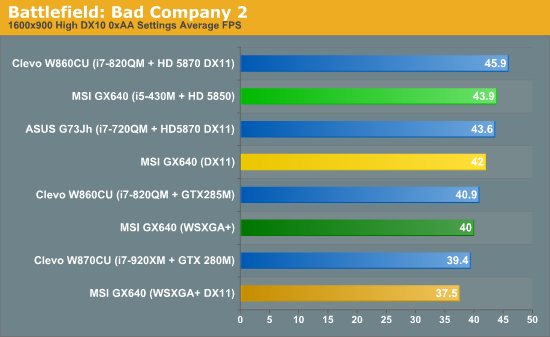
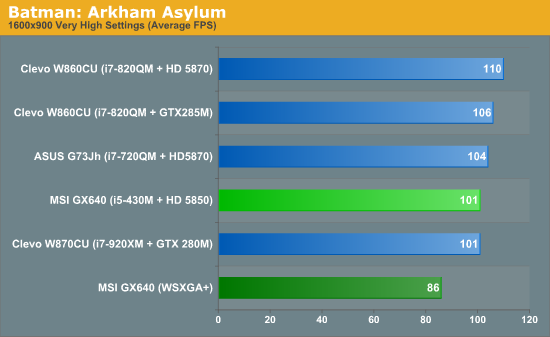
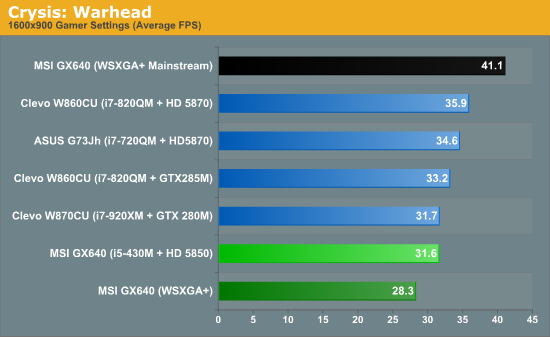
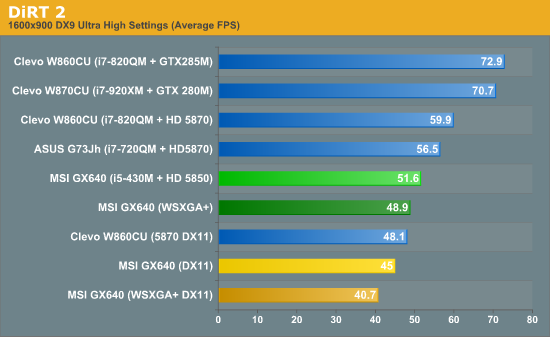
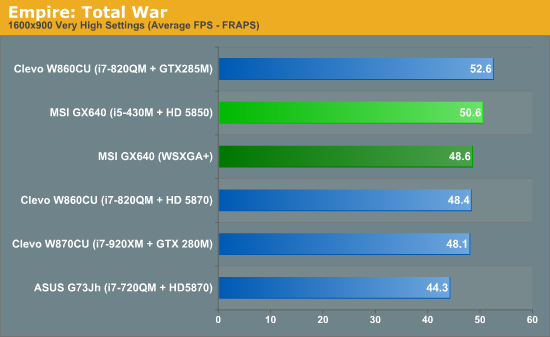
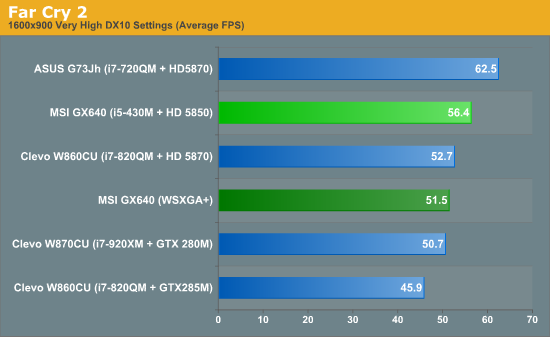
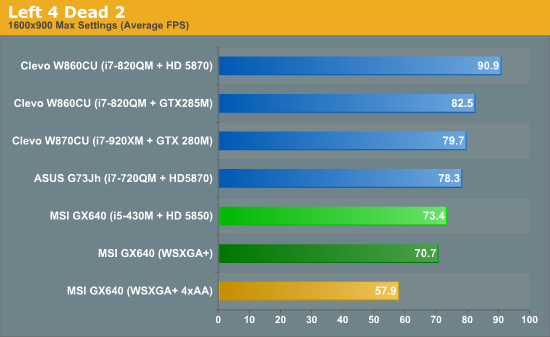
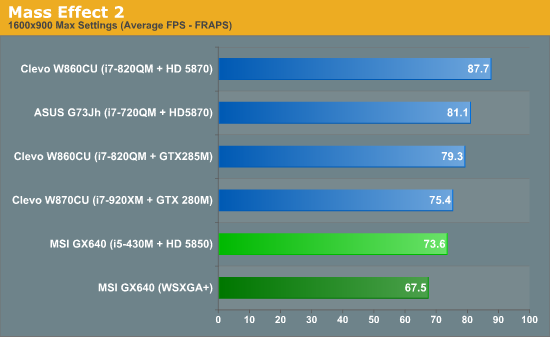

The HD 5850 ends up trailing the 5870 in most titles as expected, but the margin varies according to the demands of the game. Shader heavy games come closer to the 20% core clock difference, and in some instances the combination of i7-820QM with 5870 trumps the i5-430M with 5850 by more than 20% (L4D2 and Stalker DX11). In other games that depend more on memory bandwidth the laptops are a lot closer in performance. Oddly enough, there are even a few cases where the GX640 beats the G73Jh and W860CU—Empire Total War and Far Cry 2, to be specific. It's possible that the code on those titles is such that the quad-core chips can't hit their higher Turbo speeds, allowing the 430M to beat them. Overall, though, the GX640 places where we would expect, and it's more than capable of running any current title at high settings (Mainstream for Crysis) and 1680x1050.
As for the NVIDIA comparison, there are titles where the 5850 beats the 285M and others where NVIDIA leads. Most of the time the difference is ±7%, but DiRT 2 has the 285M leading by 41% (in DX9 mode), 17% in Call of Pripyat (DX10 mode), and 12% in L4D2. On the flip side, the 5850 beats the 285M by 22% in Far Cry 2 and 7% in BFBC2. Overall, the performance is generally close enough that we'd call the two "equal". In terms of extras, you need to decide whether you place more weight on CUDA/PhysX or on DX11 features.
Looking to the future, the NVIDIA information on their GTX 480M indicates that it will be around 30% faster than the 5870 in many titles. Given we're looking at a $500+ price premium, that may or may not be enough. More to the point, there aren't any other low-end DX11 parts coming from NVIDIA just yet, so the HD 5850 occupies a sweet spot in terms of laptop price and performance. You can get a laptop with a faster CPU or GPU, or even spend the money on a fast SSD. Those things bump up the price quite a bit, and short of GPU upgrades they won't do a lot for gaming right now. In that respect, the GX640 is a very impressive piece of mobile gaming goodness. A laptop with DX11 and 1680x1050 gaming for $1100 is going to be hard to beat, though you can ditch mobility and buy a basic desktop with an HD 5770 for quite a bit less and get better performance. As always, mobility has its price.










28 Comments
View All Comments
Ben.' - Sunday, June 13, 2010 - link
In your tests, you are saying you use a 5850 but in specs it says 5870?Ben.' - Sunday, June 13, 2010 - link
never mind"For games that support DirectX 11, we also tested it on the 5850 and will highlight those results (or 4xAA) in gold."
tipoo - Sunday, June 13, 2010 - link
I really wish you guys included Windows laptop graphs in the Macbook Pro reviews, and Macbook Pro graphcs in Windows laptop reviews.Flunk - Sunday, June 13, 2010 - link
There really wouldn't be much point in this particular case because Apple doesn't make a laptop designed for gaming. The best GPU you can get in a Macbook Pro is the Geforce 330M which is not even close to being competitive with the GPUs included in these benchmarks.tipoo - Sunday, June 13, 2010 - link
True, but at least for the battery life comparisons for the Macbook Pro review.JarredWalton - Monday, June 14, 2010 - link
The battery life tests that Anand runs on the MacBook aren't quite the same as the tests I run on Windows. I run Idle (best-case), Internet only (just browsing web with Flash, but no music playing), and x264 720p playback. Anand does a light Internet surfing test while looping MP3s in iTunes, a Flash Internet test (but using different web pages than my Windows test), Xvid playback (720p? I don't know), and a torture test with Xvid + iTunes + Internet.Since they're not using the same testing scenarios, I'm hesitant to compare the two directly. In general, MacBooks seem to have better battery life than similarly specced Windows laptops under similar loads. So CULV on Windows can last 10 hours on a 63Wh battery... and Mac does the same thing with a regular Core 2 Duo processor on a 63Wh battery. Or looked at another way, the ASUS U30Jc manages similar battery life to a typical 13" MacBook, but it does it with an 84Wh battery.
Penti - Thursday, December 16, 2010 - link
Bootcamp?rwei - Sunday, June 13, 2010 - link
This laptop reminds me pretty heavily one of the HP Envy series - you mentioned the 15 but there are now also 17 and (soon) 14 models.Having just ordered a 17 for ~$1200 after coupon, I'm surprised that one week after they began shipping (and days after people started receiving them), there still isn't a single review for it anywhere.
It might make for an interesting comparison. How much does $300 (base price) net you in build quality, screen, speakers, keyboard, etc?
NecessaryEvil-BC - Sunday, June 13, 2010 - link
You need to update your review to correct your mistake.Incidentally, MSI's GE-600 comes in at $200 less, drops the 5850 for a 5730, drops the aluminum for glossy plastic, drops the 15.4" 1680x1050 for a 16" 1366x768, but does gain switchable video. It's too bad this feature was omitted here.
JarredWalton - Sunday, June 13, 2010 - link
Odd... I tried to put a USB connector in there, and the specs do not indicate it's a combo port, as they only list "2 x USB": http://www.msimobile.com/level3_productpage.aspx?c...However, I tried again after your comment, and it turns out the eSATA port is just a *very* tight fit with USB devices. So the review is updated.
Note that the GE600 GPU is a substantial step down; the 5730 is only slightly faster than the 5650 in the 5740G (about a 20% increase in core clock -- 650 vs. 550 -- but with the same memory bandwidth). I didn't test the two laptops at the same resolution, since the 5740G is a 1366x768 panel, but it looks like half the performance at the same resolution is going to be pretty accurate. It has half the SPs (at about the same clock speed), and about one fourth the memory bandwidth.
As regarding switchable graphics, I glossed over the topic in the review, but there's plenty more to say. While it's good for battery life, there are a lot of complications on high-end laptops. First, if you have a laptop that you want to support quad-core i7, you can't do switchable unless you build in support for doing discrete *and* switchable in the same chassis. No one does that yet, as it's a big cost, so I understand the lack of switching graphics on the GX640. Optimus doesn't get around the requirement either because it has to transfer data over the bus to the IGP, so if there's no IGP present you're out of luck. I suppose what we need is quad-core mobile CPUs with an IGP, or else you have to decide to limit a laptop to only dual-core Arrandale CPUs.